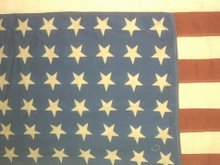At 17, a young factory worker named Geraldine Doyle unwittingly inspired J. Howard Miller’s iconic “We
This Day in HistoryThe "original" Rosie the Riveter, who inspired Redd Evans and John Jacob Loeb to write the 1942 song of the same name, was Rosalind P. Walter, who came from a wealthy New York family and worked as a riveter building fighter planes on the night shift.
In 1942, a United Press International photographer visited a metal pressing factory outside Detroit and took a snapshot of a slim, fresh-faced brunette leaning over a machine. The picture enchanted the graphic artist J. Howard Miller, who had been hired by the Westinghouse Company to design a series of motivational posters aimed at boosting female factory workers’ morale. He incorporated its pretty young subject’s face and polka-dot headscarf into one of the posters, which features a determined-looking woman flexing her right bicep under the slogan “We Can Do It!” Decades later, the poster became one of America’s most recognizable emblems of women’s empowerment, spawning countless imitations and reproduced on everything from mugs and magnets to postage stamps.
Geraldine Hoff Doyle, the real-life inspiration behind the iconic poster, died on December 26 in Lansing, Michigan, at the age of 86. Just 17 when the photographer captured her, she had taken a factory job after graduating high school, one of 6 million women who entered the workforce during World War II to plug gaping holes in the industrial labor force. An aspiring cellist, Doyle left after just two weeks of employment when she learned that the machinery had badly injured another worker’s hands. She found a position at a soda fountain and bookstore, where she met her future husband, Leo, in 1943. The couple had six children and ran a successful dental practice.
More than four decades would go by before Doyle learned of the poster’s existence and discovered that her likeness had inspired a pop culture reference. Paging through a magazine one day in 1984, she spotted a photograph of the poster and recognized her younger self. In a 2002 interview with the Lansing State Journal, Doyle, who began making frequent appearances in Michigan to sign posters, explained that motherhood and daily life had kept her too busy to realize she had become the face of Rosie the Riveter. "I was changing diapers all the time," she said.
Unlike another famous depiction, painted by Norman Rockwell and featured on a Saturday Evening Post cover in 1943, the “We Can Do It!” poster was not originally intended as a portrayal of Rosie the Riveter, who was first immortalized in a 1942 hit song and starred in numerous government-sponsored recruitment campaigns. One of many in Miller’s series, the poster was barely seen outside Westinghouse factories in the Midwest, where women were making plastic helmet liners. It was not until later, when feminists rediscovered the poster during the 1970s and 1980s, that it achieved its iconic status and became associated with the World War II-era character.




No comments:
Post a Comment